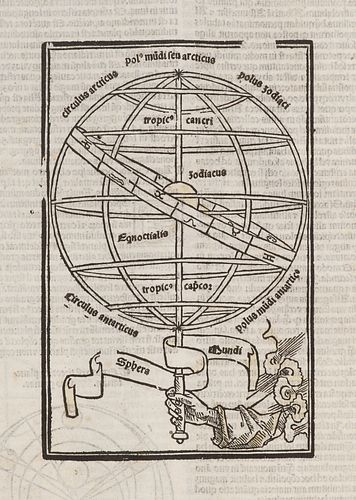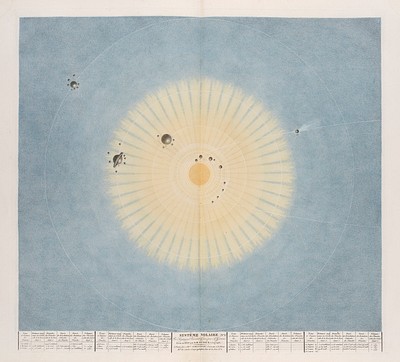Sacrobosco, Sphera Mundi
Lot 43
Absentee vs Live bid
Two ways to bid:
- Leave a max absentee bid and the platform will bid on your behalf up to your maximum bid during the live auction.
- Bid live during the auction and your bids will be submitted real-time to the auctioneer.
Bid Increments
| Price | Bid Increment |
|---|---|
| EUR€0 | EUR€10 |
| EUR€100 | EUR€10 |
| EUR€200 | EUR€20 |
| EUR€300 | EUR€30 |
| EUR€420 | EUR€30 |
| EUR€480 | EUR€20 |
| EUR€500 | EUR€50 |
| EUR€2,000 | EUR€200 |
| EUR€3,200 | EUR€300 |
About Auction
By Jeschke Jádi Auctions Berlin GmbH
Dec 15, 2022
Set Reminder
2022-12-15 09:00:00
2022-12-15 09:00:00
America/New_York
Bidsquare
Bidsquare : Auction 145 – Rare Books, Decorative Prints, Historical Photography
https://www.bidsquare.com/auctions/jeschke-van-vliet/auction-145-rare-books-decorative-prints-historical-photography-11466
Jeschke Jádi Auctions Berlin GmbH info@jvv-berlin.de
Jeschke Jádi Auctions Berlin GmbH info@jvv-berlin.de
- Lot Description
Mathematik Sacrobosco (Sacrobusto), Johannes Sphera Mundi novit recognita cu(m) co(m)me(n)tariis & autorib(us) in hoc volumine co(n)te(n)tis vz. Cichi Eschulani cum textu / Ioannis Baptiste Capuani / Jacobi Fabri Stapulensis / Theodosii de spheris cum textu / Michaelis Scoti questiones / Petri de Aliaco cardinalis q(uaesti)ones / Roberti Linconiensis Compendium / Theodosij iterum de spheris cum textu / Tractatus de sphera solida / Theorice planetarum conclusiones cum expositione / Campani Tractatus de sphera / Eiusdem tractatus de computo maiori / Joannis de monte regio in cremone(n)sem disputatio / Theorice textus cu(m) Joa(n)nis Baptiste Capuani exp(ositi)one / Ptolomeus De speculis / Theorica planetarum Joannis Cremonensis, plurimum faciens ad disputationem ioannis de monte regio, qua(m) in aliis hactenus i(m)pressis non reperies. Mit zahlr. tls. kol. Textholzschnitten, darunter eine ganzseitige Darstellung einer Armillarsphäre, Holzschnitt-Initialen u. Holzschnitt-Druckermarke am Ende. (Kolophon am Ende:) Venetiis impensis nobilis viri dni Luce Antonii de giuta Florentini. Die ultimo Junii. 1518. 233 Bll. (sign. A6, B-z8, Aa-Ff8, Gg6) (fehlerhafte Folierung: Nummer 5 wiederholt, Blätter 181-231 u. 233 falsch nummeriert 201-251 u. 253). Flex. Pgt. auf 6 durchgezogenen Bünden mit hs. RTitel u. span. Kanten (wellig, fleckig, Rücken angestaubt, Rückdeckel mit altem Pgt. erneuert, obere Ecke des VDeckel mit mont. Pgt.-Ausschnitt verstärkt). First Giunta edition. With numerous partly col. text woodcuts, incl. one full-page depicting of an armillary sphere, woodcut initials and wodcut printer's device at the end. 233 leaves (sign. A6, B-z8, Aa-Ff8, Gg6) (errors in foliation: number 5 repeated and leaves 181-231, 233 mis-numbered 201-251, 253). Flex. vellum with ms. title (wavy, spotted, spine soiled, back cover renewed with old vellum, upper corner of front cover reinforced with mounted piece of vellum). - One of two slightly different collections of astronomical works published in Venice in 1518 by the heirs of Ottaviano Scoto and here by Lucantonio Giunta (1457-1538), containing important commentaries on Sacrobosco's Tractatus de sphaera and on the Theoricae novae of Francesco Capuano da Manfredonia, and first printed in Venice towards the end of 1499. Capuano was a professor of astronomy in Padua and had already published a commentary on Peuerbach's Theoricae planetarum in 1495. He subsequently joined the ranks of the regular Lateran canons under the name Giovanni Battista. Later editions of his commentary on Sacrobosco's Tractatus were published under the name Giovanni Battista Capuano and contain a revised text of the work. Capuano's work was juxtaposed with the commentary on the Sphaera by Cecco d'Ascoli (Francesco Stabili) (1257-1327), who was sentenced to death by the Inquisition for certain astrological statements. In Capuano's work, the natural philosophical texts of Aristotle, the Almagest of Ptolemy (c. 100-170) and the Compendium of Astronomy by Al-Farghani (c. 800-870) serve as the basis for the explanation of Sacrobosco's work. Only very rarely are other sources mentioned. The Compendium sphaerae written by Robert Grosseteste and especially Pierre d'Ailly's Quaestiones subtilissimae on Sacrobosco's work are of great importance and form a very interesting text that touches on some of the most debated questions in medieval astronomy: e.g. the number of celestial spheres, the variation of the inclination of the ecliptic and the question of whether eccentric orbits and epicycles are necessary to "keep up appearances of planetary motions". In the 1518 editions, the Expositio of the Sphaera attributed to Michael Scot and the Tractatus de sphaera by Campanus of Novara (c. 1220-1296) first appear in this collection. - Also included: Cecco d'Ascoli, Lefevre d'Etaples, Gerard of Cremona, Theodosius Bithynia. - Endpapers renewed, some leaves with small worm traces and minor loss of text, paper slightly wavy, some annotations with ink in the margins, at the beginning somewhat waterstained at the inner margin, otherwise mainly a clean and well preserved copy. Erste Giunta-Ausgabe. - EDIT 16, 29259. - Hamel 64: "Neudruck, der sich jedoch in der gesamten Ausführung eng an 1518 (d.i. die im Jan. bei Scotus in Venedig ersch. Ausgabe) anlehnt, einschl. eines Paginierungsfehlers ... Die Figuren wurden offenbar nach neuen Holzschnitten ausgeführt". - Houzeau-L. 1642. - Vgl. Sander 6671 (Scotus 1518). - Nicht in Adams u. Renouard. - Riccardi I, 447-49 (rara collezione). - Sotheran Supp. II, 3790. - Lynn Thorndike, The Sphere of Sacrobosco (Chicago, 1945), S. 343. - Elio Nenci. Francesco Capuano di Manfredonia. In: Matteo Valleriani (Hg.). De sphaera of Johannes de Sacrobosco in the Early Modern Period. S. 91ff. - Eine von zwei leicht unterschiedlichen Sammlungen astronomischer Werke, die 1518 in Venedig von den Erben Ottaviano Scotos und hier von Lucantonio Giunta (1457-1538) herausgegeben wurden und die wichtige Kommentare zu Sacroboscos Tractatus de sphaera und zu den Theoricae novae von Francesco Capuano da Manfredonia enthalten, und die erstmals gegen Ende des Jahres 1499 in Venedig gedruckt wurden. Capuano war Professor für Astronomie in Padua und hatte bereits 1495 einen Kommentar zu Peuerbachs Theoricae planetarum veröffentlicht. Anschließend trat er unter dem Namen Giovanni Battista in die Reihen der regulären Laterankanoniker ein. Spätere Ausgaben seines Kommentars zu Sacroboscos Tractatus wurden unter dem Namen Giovanni Battista Capuano veröffentlicht und enthalten einen überarbeiteten Text des Werks. Capuanos Werk wurde dem Kommentar zur Sphaera des wegen bestimmter astrologischer Aussagen von der Inquisition zum Tode verurteiltvon Cecco d'Ascoli (Francesco Stabili) (1257-1327) gegenübergestellt. In Capuanos Werk dienen die naturphilosophischen Texte des Aristoteles, der Almagest des Ptolemäus (um 100-170) und das Kompendium der Sternenkunde von Al-Farghani (um 800-870) als Grundlage für die Erläuterung des Werks von Sacrobosco. Nur sehr selten werden andere Quellen erwähnt. Das von Robert Grosseteste verfasste Compendium sphaerae und vor allem Pierre d'Aillys Quaestiones subtilissimae zu Sacroboscos Werk sind von großer Bedeutung und bilden einen sehr interessanten Text, der einige der am meisten diskutierten Fragen der mittelalterlichen Astronomie berührt: z.B. die Anzahl der himmlischen Sphären, die Variation der Neigung der Ekliptik und die Frage, ob exzentrische Bahnen und Epizykel notwendig sind, um "den Schein der Planetenbewegungen zu wahren". In den Ausgaben von 1518 erscheinen die Michael Scot zugeschriebene Expositio of the Sphaera und der Tractatus de sphaera von Campanus von Novara (um 1220-1296) erstmals in dieser Sammlung. - Außerdem enthalten: Cecco d'Ascoli, Lefevre d'Etaples, Gerard of Cremona, Theodosius Bithynia. - Vorsätze erneuert, einige Blätter mit kl. Wurmspuren u. geringem Textverlust, einige Anm. mit Tinte im Rand, Papier leicht wellig, anfangs am Innensteg etwas wasserrandig, sonst vorwiegend sauberes u. wohlerhaltenes Exemplar. * Dieses Werk ist regelbesteuert. Auf den Zuschlagspreis fallen 23,95% Aufgeld sowie auf den Rechnungsendbetrag 7% bzw. 19% Mehrwertsteuer in der Europäischen Union an. This work is subject to the regular margin scheme. There is a 23.95% buyer's premium on the hammer price and 7% or 19% VAT on the final invoice amount in the European Union.Sacrobosco (Sacrobusto), Johannes Sphera Mundi novit recognita cu(m) co(m)me(n)tariis & autorib(us) in hoc volumine co(n)te(n)tis vz. Cichi Eschulani cum textu / Ioannis Baptiste Capuani / Jacobi Fabri Stapulensis / Theodosii de spheris cum textu / Michaelis Scoti questiones / Petri de Aliaco cardinalis q(uaesti)ones / Roberti Linconiensis Compendium / Theodosij iterum de spheris cum textu / Tractatus de sphera solida / Theorice planetarum conclusiones cum expositione / Campani Tractatus de sphera / Eiusdem tractatus de computo maiori / Joannis de monte regio in cremone(n)sem disputatio / Theorice textus cu(m) Joa(n)nis Baptiste Capuani exp(ositi)one / Ptolomeus De speculis / Theorica planetarum Joannis Cremonensis, plurimum faciens ad disputationem ioannis de monte regio, qua(m) in aliis hactenus i(m)pressis non reperies. Mit zahlr. tls. kol. Textholzschnitten, darunter eine ganzseitige Darstellung einer Armillarsphäre, Holzschnitt-Initialen u. Holzschnitt-Druckermarke am Ende. (Kolophon am Ende:) Venetiis impensis nobilis viri dni Luce Antonii de giuta Florentini. Die ultimo Junii. 1518. 233 Bll. (sign. A6, B-z8, Aa-Ff8, Gg6) (fehlerhafte Folierung: Nummer 5 wiederholt, Blätter 181-231 u. 233 falsch nummeriert 201-251 u. 253). Flex. Pgt. auf 6 durchgezogenen Bünden mit hs. RTitel u. span. Kanten (wellig, fleckig, Rücken angestaubt, Rückdeckel mit altem Pgt. erneuert, obere Ecke des VDeckel mit mont. Pgt.-Ausschnitt verstärkt).
Condition
- Buyer's Premium



 EUR
EUR CAD
CAD AUD
AUD GBP
GBP MXN
MXN HKD
HKD CNY
CNY MYR
MYR SEK
SEK SGD
SGD CHF
CHF THB
THB







